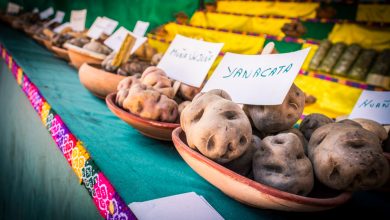Giant White Corn, Cuzco’s Heart

Peru has many distinctive foods, but the ”giant white corn of Cuzco”, known for its large kernels, is one of the first to obtain a denomination of origin. The white corn gained this honor after an arduous bureaucratic process in 2006 while a year ago, January 2010, the traditional “knowledges, uses and technologies” associated with this corn in Cuzco’s Sacred Valley gained another distinction as “National Cultural Patrimony”.
In both cases, the distinction celebrates a relationship between food and place and between food and culture. The long mountain valley through which the Vilcanota river meanders is the heart of Cuzco, both now and in times past. It is a complex ecosystem in which high mountain pastures and potato fields are connected with the broad fields of corn of the valley’s floor in a single system of culture and food. And, the production of white corn is at its center.
For the Incas corn was associated with the sun. The opening of the fields and the harvest were matters of state ritual. From corn, not only came food, but when fermented came chicha the state brew. Not only did the Incas consume large amounts of the drink such that the Spaniards commented on their drinking and the resulting drunkenness, their descendants still drink chicha today. The flag announcing the presence of the drink for consumption appears on doorway after doorway throughout the Andes and chicherías, or places where chicha and food can be purchased are important in local culture, though few tourists make their way to them.
Chicha was also fed in massive quantities to the earth, the mother of the universe, and to the mountains and sky. Even today, people will flick the foam from glasses of beer and pour the first bit of it and of chicha to the earth to share their drink with the world around them.
Called sara in the indigenous Quechua, or mamasara, lady or mother corn, maize is a food that is both culturally and economically important. Around it is grows the culture and economy.

The white corn of Cuzco, one of perhaps eight varieties of corn cultivated in the sacred Valley, is called paraqay sara in Quechua and is the most broadly commercialized of the valley’s inventory of corn. Not only is the corn consumed in Cuzco and other parts of Peru, it is widely exported. Last year $6.8 million US dollars worth of corn was exported. Of that 68% went to Spain, 21% to Japan, and 6% to the United States.
Mostly cultivated by small and medium sized producers, the corn fields are one of the main sources of labor in the valley, besides tourism. Workers come from their homes high up the mountain slopes to work the fields seasonally making corn an economic heart of the region.
It is important in ritual, such as the ritual of the first haircut, the rutucha, as shown in the photo accompanying this post. It also fills folklore, such as stories of how corn and other foods originated when the fox fell from the sky and its stomach split open spilling corn and other foods over the earth. It is also told that corn was originally a young woman sacrificed to the earth but who now is a plant that every year grows and feeds the people.
Though corn is found traditionally throughout the Western Hemisphere and has now spread throughout the world, where it is one of the main human staples–as well as an increasingly industrialized product–the white corn of Cuzco celebrates local connections. A specific historic variety is tied to a place its culture and its economy. Nothing is better than eating it kernel by kernel while the world of Cuzco swirls by.
Sources and more information:
If you read Spanish, more information and sources for this post can be found here, here, here, and here.





Please let me the machinery used to pop Cuzco corn
Hi George,
Cuzco’s giant white corn is not the corn used for toasting (popping), although it can be deep fried and transformed as int eh snack food found in many places. If you are asking about maná, the large popped corn you find for sale in some places, then that is corn popped under pressure, I believe. I have never thought to ask about the machinery although I can if that is your request. Please let me know.
Other kinds of “popped” corn, such as the parched corn served in restaurants and buyable in small bags, canchitas, is any of a number of varieties of corn, such as maiz chullpi, toasted in a pan usually with a little oil. These varieties do not pop into the fluffy white flowers, instead they transform and soften. Occasionally one will actually pop.
Let me know if there is more you wish to know.